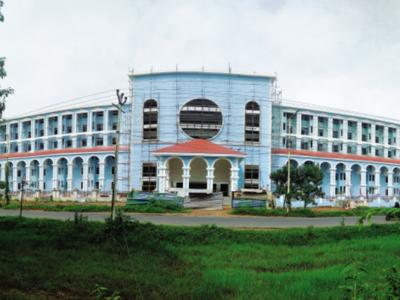South Goa hospital strengthens its paediatric care facilities

Apart from a new paediatric ward, six neo natal care units have also been created in the district hospital, nodal officer Dr Rajesh Patil said
MARGAO: With the second wave of the pandemic now on the wane, the South Goa district Covid hospital is bracing itself for the anticipated third wave.
And considering that children are likely to be vulnerable to the virus during the third wave, the South Goa district hospital has focused on strengthening its paediatric care facilities.
Apart from a new paediatric ward, six neo natal care units have also been created in the hospital, nodal officer Dr Rajesh Patil told reporters on Sunday.
Stating that audit of the existing ventilators has been initiated, Patil said that experts were on the job to make them suitable for use for paediatric patients.
Besides as intensive care units (ICU) and intensive treatment unit (ITU), a five bedded high dependency unit has been created near the casualty ward that is equipped with a ventilator. Critical patients coming to the hospital are first admitted to the high dependency unit where they are stabilised before shifting them to the ICU or ITU, thereby preventing any delay in treatment, Patil said.
Facilities for providing dialysis treatment to kidney patients have also been made available at the hospital.
Patil said that the hospital’s focus has also been on providing post Covid care as cases of pulmonary fibrosis post-Covid infection have been on the rise.
A post-Covid Ayush centre has also been opened at the South Goa district hospital where Ayush doctors train patients in breathing exercises, it was informed.
Patil further said that the hospital has been sending swabs of Covid positive patients, particularly of those having severe infection, and those who have contracted the infection despite being fully vaccinated, for genomic sequencing.
“Once we get the reports, we will be able to determine which variant is in circulation, and which is more serious, and accordingly appropriate treatment will be given to the patients,” Patil said.
And considering that children are likely to be vulnerable to the virus during the third wave, the South Goa district hospital has focused on strengthening its paediatric care facilities.
Apart from a new paediatric ward, six neo natal care units have also been created in the hospital, nodal officer Dr Rajesh Patil told reporters on Sunday.
Stating that audit of the existing ventilators has been initiated, Patil said that experts were on the job to make them suitable for use for paediatric patients.
Besides as intensive care units (ICU) and intensive treatment unit (ITU), a five bedded high dependency unit has been created near the casualty ward that is equipped with a ventilator. Critical patients coming to the hospital are first admitted to the high dependency unit where they are stabilised before shifting them to the ICU or ITU, thereby preventing any delay in treatment, Patil said.
Facilities for providing dialysis treatment to kidney patients have also been made available at the hospital.
Patil said that the hospital’s focus has also been on providing post Covid care as cases of pulmonary fibrosis post-Covid infection have been on the rise.
A post-Covid Ayush centre has also been opened at the South Goa district hospital where Ayush doctors train patients in breathing exercises, it was informed.
Patil further said that the hospital has been sending swabs of Covid positive patients, particularly of those having severe infection, and those who have contracted the infection despite being fully vaccinated, for genomic sequencing.
“Once we get the reports, we will be able to determine which variant is in circulation, and which is more serious, and accordingly appropriate treatment will be given to the patients,” Patil said.
FacebookTwitterLinkedinEMail
Start a Conversation
end of article
Quick Links
Delhi Air PollutionDelhi TemperatureChennai WeatherBangalore TemperatureCovid vaccination centres in DelhiCoronavirus in DelhiRTPCR test in GurgaonHyderabad RainPollution level in BangaloreDelhi SmogDelhi TemperatureNoida AQIGurgaon AQI todayFire in MumbaiMumbai RainsCovid 19 RT PCR Test in NoidaDelhi AQI todaySrinagar encounter
